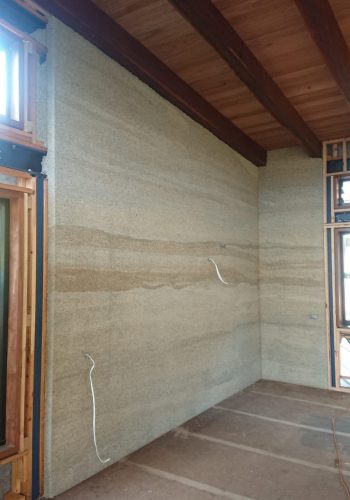Towards a Sustainable Tomorrow
TRADICAL® HEMPCRETE
WHAT IS TRADICAL® HEMPCRETE
Tradical® Hempcrete is a CodeMark certified construction material that combines a lime-based binder, building-grade hemp hurd and water to form a bio-composite material that is a lightweight, sustainable and environmentally friendly alternative to traditional building materials.

Building with Tradical® Hempcrete is a sustainable construction method as the hemp is grown and processed without any harmful substances and with minimal environmental impact.
Tradical® Hempcrete is a non-structural and lightweight material that can be used to form solid thermal walls of framed buildings and provide an excellent and breathable insulation wall form. Due to its superior thermal properties and strong moisture-regulating effects, Tradical® Hempcrete contributes to a comfortable and healthy indoor climate.
Tradical® Hempcrete has significant advantages over concrete as it is breathable, fire resistant and provides excellent insulation. It is also energy-saving, it does not rot nor burn, and it is termite and mould resistant.
CHARACTERISTICS OF TRADICAL® HEMPCRETE

Excellent Thermal Insulation
Tradical® Hempcrete houses provide superior thermal insulation compared to conventional houses. For example, the exterior walls of conventional houses are traditionally 4-6°C warmer than those of Tradical® Hempcrete houses.
This indicates that loss of heat through conventional brick walls are considerably greater than that through Tradical® Hempcrete walls.
Other Thermal Properties
Thermal conductivity tests of hempcrete walls conducted by Plymouth University have led to an agreed reading of 0.08W/mK. These were taken on a 200mm thick wall that had been constructed several years earlier.
The “R” value (thermal resistance) is 2.75 with plaster and surface resistances taken into account.
The “U” value (rate of heat loss or gain) derived from this would be in the region of 0.36 -0.37 W/m2 K.
This empirical work confirmed a Lambda value of 0.08 – 0.09 for hemp and lime.
This conservative figure has been confirmed by so many authoritative bodies that it seems to be accepted when making building regulation applications (Bevan and Woolley, 2008).
Tradical® Hempcrete regulates the temperature and humidity of a building and in some cases, eliminates the need for heating and cooling systems, resulting in huge energy savings.


Excellent Acoustic Isolation
Walls made of Tradical® Hempcrete have good acoustic absorption as it has a porous structure, contains air and elements with high porosity (hemp hurd). It also has a thickness that guarantees to absorb sound waves. When rendered, a Tradical® Hempcrete wall will reflect most of the sound ~900Vson m/s (speed of sound per m/s) and will then absorb the remaining sound waves, whereas steel has a sound absorption of ~6100 Vson m/s.
Tradical® Hempcrete is characterised by its high porosity, which combines the microscopic pores of the lime binder with the particles of the hemp hurd, and bigger pores between the particles of the hemp hurd. Thus, the sound absorption of Tradical® Hempcrete is an intermediate process between the excellent absorption of hemp hurd and the reflection of the lime binder.
Fire Retardant – Certified BAL FZ
Fire tests on a 300mm thick Tradical® Hempcrete wall gave 73 minutes for structural adequacy, integrity & insulation. This leads to a FRL (Fire Resistance Level) of 73 minutes for a 300 mm thick wall.
There is also very limited smoke development with no burning droplets or particles. The equivalence rating will only be achieved provided results from the tests are within the certifiable limits of legislation.
This has been based on the reported performance under full-scale fire exposure and the similarity of exposure and performance criteria between AS 1530.4-2014 and BS EN 1365-1:1999. Therefore, a Tradical® Hempcrete wall system shows equivalence to product ‘FRL 60/60/60’ and if tested in accordance with AS 1530.4-2014, will achieve performance compliance for use on loadbearing walls in building construction.
OzHemp’s Tradical® Hempcrete is CodeMark certified – BAL FZ (Bushfire Attack Level Flame Zone), the most extreme rating that can be applied to building design and construction.
This makes Tradical® Hempcrete suitable for use in all bushfire prone areas (Low to Flame Zone).

Termite, Rodent & Mould Resistant
Tests performed with the fiercest termites in the country have proven that termites will not eat Tradical® Hempcrete. The insect cannot withstand the pH level of the mass and will not attempt to eat it.
John French, a leading international entomologist in Queensland, has tested this in both Queensland and the Northern Territory and found that termites had no effect on Tradical® Hempcrete.
Carbon Neutral
Tradical® Hempcrete is carbon neutral and is the obvious choice for buildings aiming to achieve the highest sustainable building code levels with a low carbon footprint.
Residential construction is responsible for producing 23.8 mega tonnes of CO2 annually.
The manufacturing of synthetic insulation materials contributes enormously to their high embodied energy and the overall CO2 equation.
Hemp absorbs atmospheric CO2 during the plant growth phase and will continue to reduce atmospheric CO2 as the Tradical® Hempcrete wall cures and gains strength. Lime absorbs CO2 during its carbonation process which helps to reduce the CO2 in the air. Tradical® Hempcrete buildings act as a carbon sink, preventing the release of CO2 back into the atmosphere.
One hectare of industrial hemp can absorb 15 tonnes of CO2 per hectare. The rapid growth rate of the hemp plant makes it one of the fastest CO2-to-biomass conversion tools available, even more efficient than agroforestry. The estimated rate of carbon sequestration is 165kg CO2 capture/m². 100m² of a 300mm thick Tradical® Hempcrete wall will lock up 7.9 tons of CO2 in the walls. An average sized Tradical® Hempcrete house will remove about 20 tonnes of CO2 from the atmosphere over its lifetime.

Technical performance:
- Elasticity
- Durability
- Vapour Permeability
Value performance:
- Easy To Use
- High Yield Product
- Lower Maintenance Masonry
Environmental Performance:
- High Carbon Capture
- Sustainable Building
- Low Energy Consumption
